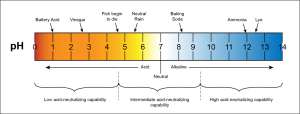This post was written by ScIU Undergraduate Intern Komal Kumar.
The discovery of extremophiles – organisms that thrive in extreme environments – completely changed scientists’ perspectives on the conditions necessary for life. These evolutionary marvels provide context for the origins of life, evolution, and are maybe the best case for the possibility of the existence of life on other planets with extreme environments. Moreover, extremophiles are being widely studied among biotechnologists and engineers to understand how we can utilize their unique capabilities. Here are some of the types of extremophiles and the characteristics that make them incredibly useful:
- Thermophiles: Thermophilic organisms thrive in environments with extreme temperatures. One of the first extremophiles discovered was a thermophilic organism – Thermus aquaticus – a species of bacteria that is often found in hot springs, whose temperatures range between 60℃ and 80℃ (140℉ – 176℉)! Not only did the discovery of T. aquaticus influence researchers to search for the existence of other extremophiles, T. aquaticus is used in a lot of research labs! To name one example, biochemists use a lab technique called polymerase chain reaction to create hundreds of copies of one DNA strand to allow researchers to study the DNA. To amplify the DNA, the original strand must be denatured at high temperatures to allow separation of the two strands, and to allow the DNA polymerase, the enzyme that creates the new strand of DNA to access the original strand. The problem? Human DNA polymerases stop functioning at high temperatures! Researchers now use a DNA polymerase from a thermophilic organism, as it can withstand the high temperatures necessary to denature DNA and function properly!

Image credit: Jacob W. Frank on flickr - Acidophiles: Acidophilic organisms, as the name suggests, thrive in acidic environments – sometimes in harsh conditions with pH 0! To put that in context, these organisms could survive in battery acid, a substance 107 times more acidic than water. While most cell walls and membranes break down in such low pHs, these organisms have evolved to maintain an internal pH of 7 (neutral), which allows them to survive. Many archaebacteria within the family Ferroplasma are acidophilic and are now widely studied. Acidophilic organisms have a variety of uses; most prominently, they’ve been used for bioleaching – a method of mining and extracting valuable metals from naturally occurring rock – allowing us to not only clean up heavy metal waste, but also to mine these heavy metals from areas where it was previously difficult to obtain. To get a better sense of the conditions in which these organisms thrive, here’s a video of a penny dissolving in nitric acid, a solution that is 1000x less acidic than battery acid!

A pH scale is logarithmic. In other words, a solution with pH 6 is ten times more acidic than a solution with pH 7, and a hundred times more acidic that a solution with pH 8! - Metallophiles: Metallophilic organisms have the unique ability to withstand high concentrations of usually lethal heavy metals, such as uranium, mercury, and cadmium. Among these organisms are various species of bacteria, fungi, and archaebacteria, and they have even been used to help clean up large-scale environmental disasters, such as oil spills, making them an important research topic!
- Halophiles: Halophilic organisms exist in hypersaline conditions, with NaCl concentrations ranging between 3%-30% (for context, seawater is about 3% NaCl). Research on halophilic organisms currently explores their use in biomedicine, as they require very few nutrients to survive. Understanding the biochemical mechanisms by which these organisms survive in extreme environments and replicating them in biotechnology may provide a pharmacological solution to treating cancer, antibiotic resistance, and other health concerns that result in increased levels of cell death and malnutrition.
- Polyextremophiles: Polyextremophilic organisms that not only survive in seemingly hostile conditions, but actually require multiple extreme environments to thrive! The bacterium Clostridium paradoxum, for example, is both a halophilic and a thermophilic organism. These organisms are an evolutionary wonder and are a great matter of interest for researchers. What makes them fascinating is that they allow researchers to suggest environments previously considered unfit to support life as just the opposite. For example, Saturn’s moon, Titan, is uninhabitable for organisms like humans with its methane atmosphere, rivers, and lakes. For a polyextremophile, however, this environment could be just what it needs to thrive.

Saturn’s moon, Titan, could potentially house life, with its methane atmosphere, rivers, and lakes. Image Credit: NASA’s Marshall Space Flight Center on flickr
These areas of study are some of the most current and exciting, and may have huge implications for progress in healthcare, the environment, and the search for life on other planets! But on an individual level? The mere existence of extremophiles suggests that our conceptions of “life” are likely too narrow. Take some time to expand your horizons and think about how much life exists around you – in the microscopic, unseen, common bacteria that exist on everything you’ll ever touch, the worms building entire ecosystems underground, and the crazy and wild microorganisms that exist in environments previously thought to be uninhabitable. Reevaluate the fundamental assumptions you may have of what life is and what it could consist of, and see how we can begin to gain a greater appreciation and understanding of seemingly monotonous ecosystems, and the complexity they carry. The next step? Hypothesizing the existence of aliens, of course. Have fun!
Edited by Gabriel Nah and Joe Vuletich

Leave a Reply